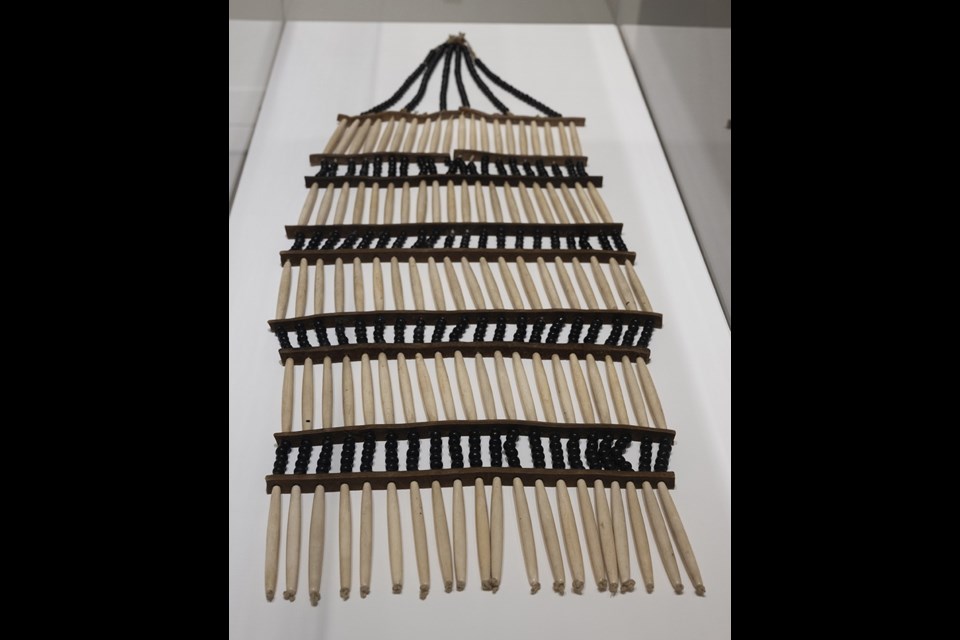MOOSE JAW — Deep in the bowels of the Moose Jaw Museum and Art Gallery, where few visitors ever go, are two rooms overflowing with thousands of artworks that are rarely shown.
There are over 11,000 items in the collection, with more than 7,000 physical artifacts — some dating to Moose Jaw’s founding in the 1880s — in one vault and over 4,000 art pieces — from paintings to metal sculptures — in a second vault.
And managing this organized chaos is Jennifer McRorie, the MJMAG’s curator/executive director.
“It’s a big responsibility, but it’s an honour,” she said. “I love working with the collection and 小蓝视频 able to create exhibitions (and) tell (endless) stories by putting different works together.
“We’re really fortunate that it’s such a diverse collection of work that really represents Saskatchewan art history and Moose Jaw art history,” she continued, noting it’s important to preserve these pieces for the future.
McRorie has worked for other arts organizations, including SaskArts, the provincial funding body, and while it has an impressive collection, it doesn’t have a venue like the MJMAG. In fact, she believes the provincial organization “would be envious” of what’s here.
“It’s pretty amazing for a city of this size to have a state-of-the-art facility like this … ,” she remarked.
McRorie acknowledged that the two vaults are “busting at the seams a little bit,” evident by many donations sitting on tables waiting to be catalogued. However, the MJMAG hopes a federal grant will help it install more racks and shelves.
McRorie gave a tour of the vault and discussed many pieces and the artists who created them.
This is part one of two.
First Nations works
Of the over 7,000 artifacts, McRorie is most fond of the First Nations items, especially the glass-beaded pieces that Dakota, Cree, Dene and Lakota peoples made.
There are many Lakota pieces because those members worked in the 1890s and early 1900s either with the Ostrander family — who donated a large collection — or Annie Wallis. Wallis befriended the Lakotas, who eventually gave her a cultural name and adopted her into their community.
The art gallery featured an , including what organizers thought was an elk teeth-decorated shirt, McRorie recalled. However, , said the “shirt” was actually the top of a dress that had been “crudely cut” since the outfit may have been damaged.
“So that was one of the great things about the wakšúpi exhibit is that we had indigenous people that are part of our advisory committee that have been doing research,” said McRorie, “and they’re continuing to do research on the collection.”
The exhibition also featured a beaded vest, although its creator was unknown. However,
McRorie said the art museum is speaking with the Wood Mountain First Nation about repatriating the sacred headdress. She noted that the MJMAG invited members of the reserve to the exhibition’s opening, gave them a tour of the vault, and held a feast.
Dave Ogle, a band councillor, told the curator that the reserve wants its youths to grow up with its sacred objects, something she understands. That’s why the art museum won’t exhibit any artifacts unless the Ferguson family says it’s OK.
McRorie also highlighted another headdress that the MJMAG received from the family of Dr. Regan, who loaned the artifact for 50 years and allowed it to be displayed. She noted that the dentist’s grandfather acquired the headdress from the Standing Buffalo First Nation near Fort Qu’Appelle because he was a community physician.
One mystery the curator faces with the headdress is figuring out what feathers were used since “they’re really unusual” and not visibly from an eagle. She has spoken with elders and knowledge keepers, while a consultant from the Museum Association of Saskatchewan plans to view it.
“… it’s actually illegal for non-indigenous people to have eagle feathers because (they’re protected under) a federal act, so that’s why we’re really looking at repatriation (of this and other items),” McRorie said, noting there are other sacred items museum personnel cannot handle unless an elder is present.
The curator added that the MJMAG’s oldest artifacts are 2,000-year-old Aboriginal pottery shards.
Frauds, fakes, forgeries
The MJMAG has around 130 paintings — with a total value over $805,000 — that it obtained from the province through the “government extended loan (GEL)” program, with many of those artworks — some from the late 19th century — from European artists.
McRorie noted that it’s easy to tell the age of some GEL paintings by the old frames and the yellowing of the varnish.
“So the interesting thing about a lot of these historic pieces in the GEL collection is a lot of them are frauds,” she continued. “So you can tell, especially (with) the ones that have these little brass plaques that (have) the artist’s name on it.”
The curator explained that there was an art dealer in the 1970s who sold fraudulent European pieces in Saskatchewan. He told collectors that the pieces were of a certain brand, appraised them and distributed them, and the collectors donated the artworks to the province.
However, the dealer was appraising the artworks at inflated prices, which meant the collectors received big tax breaks, McRorie said. So, the RCMP took all the pieces, investigated the situation, and jailed many people.
The curator added that her predecessor, Heather Smith, exhibited many of the fraudulent GEL pieces, while she is considering doing the same.
For more information about the Moose Jaw Museum and Art Gallery, visit .




